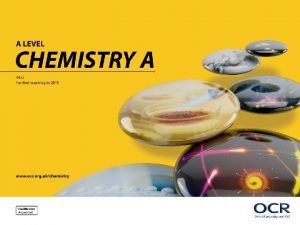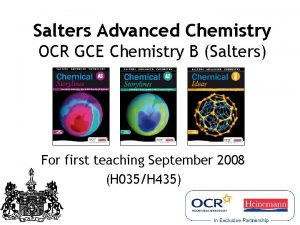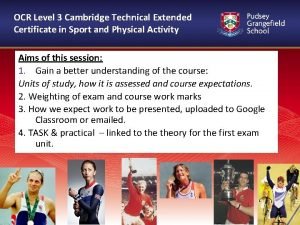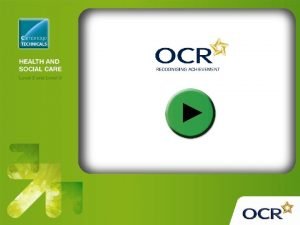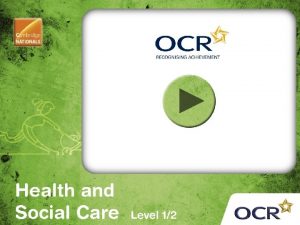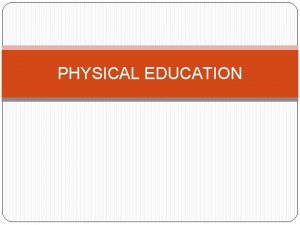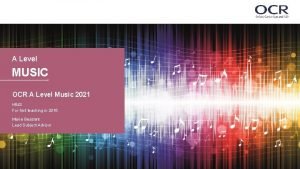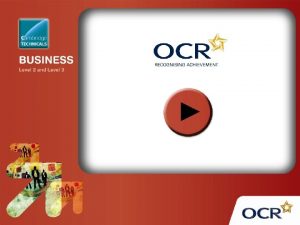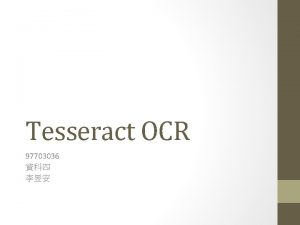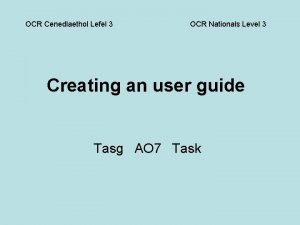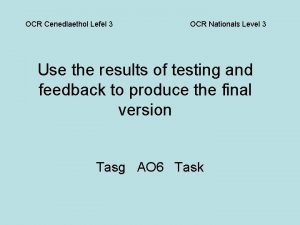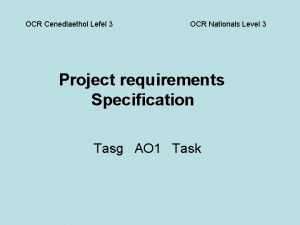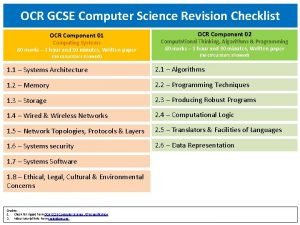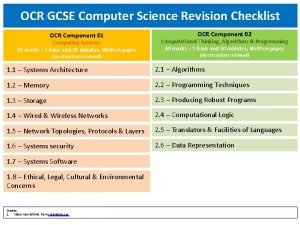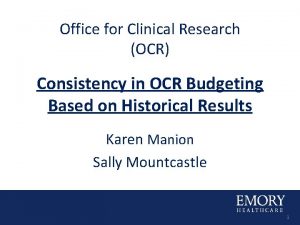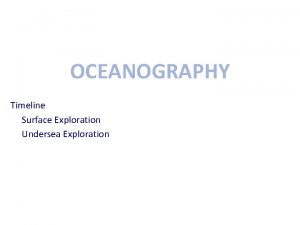OCR 2017 A Level Chemistry A Topic Exploration














- Slides: 14

© OCR 2017

A Level Chemistry A Topic Exploration Pack – Organic Synthesis Identifying functional groups © OCR 2017

• At A Level there are many functional groups to recognise and memorise. One way to deal with this large amount of information is to break it into chunks. • On the following slides, the functional groups have been grouped with other similar groups. • The names of the groups (like ‘simple functional groups’) are not official titles. They are just a reference for this activity, and you don’t need to learn them. © OCR 2017

Simple functional groups Type of compound Functional group Alkene C=C Amine –NH 2 Alcohol –OH Nitro compound –NO 2 Haloalkane –Cl; –Br; –I Nitrile –CN Alkenes include a double bond. The other groups are attached to the carbon chain or a benzene ring. © OCR 2017

Simple carbonyls Type of compound Functional group Aldehyde Ketone These have an oxygen atom double bonded to a carbon, which itself is bonded to only carbon and/or hydrogen. © OCR 2017

Compound carbonyls Type of compound Functional group Carboxylic acid Acyl chloride Cl 1° amide These have an oxygen atom double bonded to a carbon, which is bonded to another atom other than carbon or oxygen. © OCR 2017

Bridging groups Type of compound Functional group Ester 2° amide (peptide) Acid anhydride Here, a carbon is double bonded to an oxygen and bonded to another atom other than carbon or hydrogen. This atom in turn is bonded to another carbon chain. © OCR 2017

Organic salts Functional group Diagram Carboxylate salt Phenoxide salt These have a metal ion bonded to an oxygen ion. The metal is most commonly sodium. © OCR 2017

Aromatics / arenes These contain a benzene ring, often with alkyl groups or other functional groups attached. © OCR 2017

Phenols © OCR 2017 These contain a benzene ring with a –OH group directly attached, often with other alkyl groups or functional groups attached.

Identifying the groups • When given a complex unknown molecule it is important to be able to rule out certain groups to make identifying it easier. • The following flow chart should help you to reduce the number of options down quickly. • The blue boxes are key questions to help you rule certain options in or out. © OCR 2017

Is there a benzene ring? Yes Is there a –OH directly attached? Yes Phenols No No Does the main chain contain anything but carbon? Aromatics Yes Bridging groups No Does it have a C=O bond No © OCR 2017 Simple functional groups Yes Does the carbon have any other groups attached? No Simple carbonyls Yes Compound carbonyls

Tasks • The worksheet contains pictures of molecules. For each molecule you need to identify all of the functional groups. • For an extra challenge, have a go at naming the basic compounds. • The advanced molecules are intended to have some discussion points for the group. © OCR 2017

Thank you for using this OCR resource Other OCR resources are available at www. ocr. org. uk To give us feedback on, or ideas about the OCR resources you have used, email resourcesfeedback@ocr. org. uk OCR Resources: the small print OCR’s resources are provided to support the teaching of OCR specifications, but in no way constitute an endorsed teaching method that is required by the Board, and the decision to use them lies with the individual teacher. Whilst every effort is made to ensure the accuracy of the content, OCR cannot be held responsible for any errors or omissions within these resources. © OCR 2017 - This resource may be freely copied and distributed, as long as the OCR logo and this message remain intact and OCR is acknowledged as the originator of this work. © OCR 2017
 A level chemistry ocr organic synthesis
A level chemistry ocr organic synthesis Ocr chemistry b
Ocr chemistry b Cambridge technicals level 3 business
Cambridge technicals level 3 business Ocr level 3 sport and physical activity
Ocr level 3 sport and physical activity Ocr cambridge technicals
Ocr cambridge technicals Ocr cambridge technicals level 3 sport unit 3 revision
Ocr cambridge technicals level 3 sport unit 3 revision Ocr health and social care
Ocr health and social care Worksheet 2 searching algorithms answers
Worksheet 2 searching algorithms answers Ocr
Ocr Image ocr
Image ocr Ctec business unit 2
Ctec business unit 2 Ocr health and social care
Ocr health and social care Lmi4all
Lmi4all Clincher sentence
Clincher sentence Topic about internet
Topic about internet
